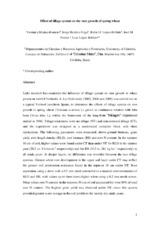Effect of tillage system on the root growth of spring wheat
Autor
Muñoz-Romero, Verónica
Benítez-Vega, Jorge
López-Bellido Garrido, Rafael J.
Fontán, José M.
López Bellido, Luis
Editor
SpringerLinkFecha
2009Materia
VertisolNo tillage
Conventional tillage
Root-length density
Root biomass
Root N
METS:
Mostrar el registro METSPREMIS:
Mostrar el registro PREMISMetadatos
Mostrar el registro completo del ítemResumen
Little research has examined the influence of tillage system on root growth in wheat grown on rainfed Vertisols. A 3-year field study (2003, 2004 and 2005) was carried out on a typical Vertisol (southern Spain), to determine the effects of tillage system on root growth in spring wheat (Triticum aestivum L) grown in continuous rotation with faba bean (Vicia faba L), within the framework of the long-term “Malagón” experiment started in 1986. Tillage treatments were no-tillage (NT) and conventional tillage (CT), and the experiment was designed as a randomized complete block with three replications. The following parameters were measured: above-ground biomass, grain yield, root length density (RLD), root biomass (RB) and root N content. In the topmost 10 cm of soil, higher values were found under CT than under NT for RLD in the rainiest year (20.2 km m−3 vs. 9.6 km m−3 respectively) and for RB (512 kg ha−1 vs. 261 kg ha−1 respectively) in all study years. In deeper layers, no difference was recorded between the two tillage systems. Greater wheat root development in the upper soil layer under CT may reflect the greater soil penetration resistance found in the topmost 10 cm under NT. Root separation using a sieve with a 0.5 mm mesh screen led to a marked underestimation of RLD and RB, with values up to three times higher when using a 0.2 mm mesh screen. Mean wheat root N content in the topmost 30 cm of soil accounted for over 80% of total root N content. The highest grain yield was observed under NT, since this system provided greater water storage in the soil profile in the mostly dry study years.

